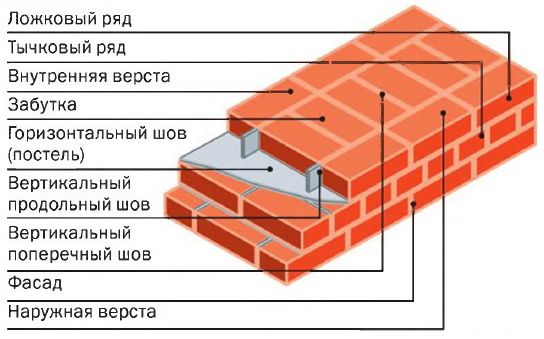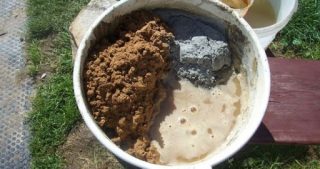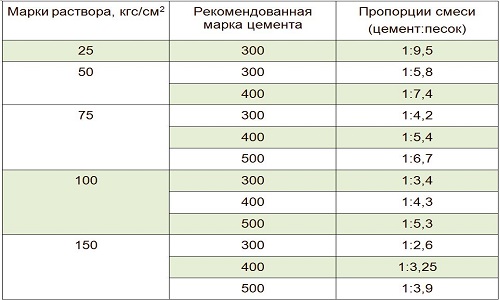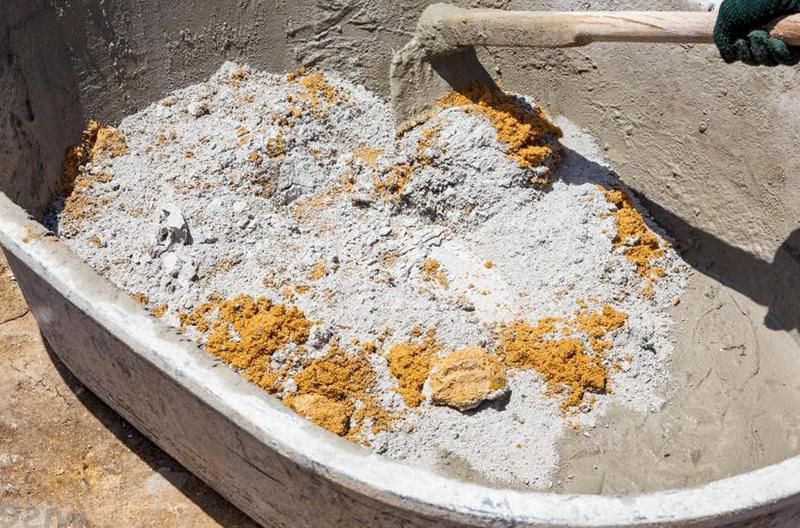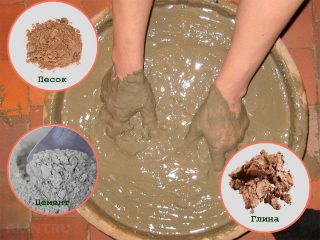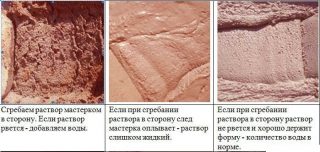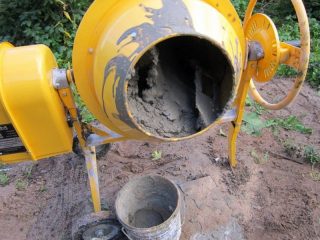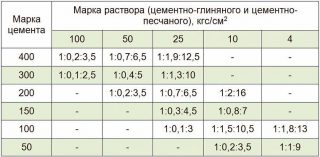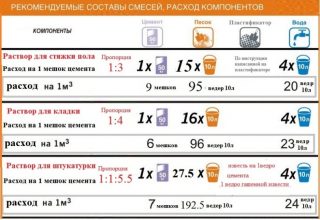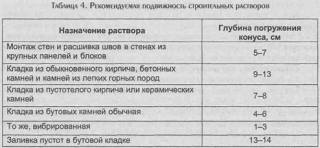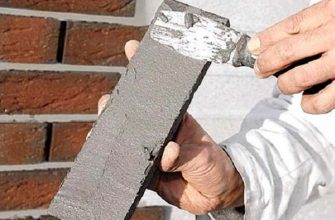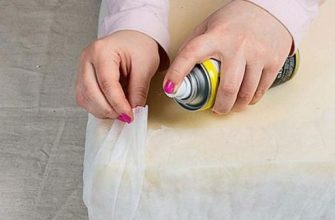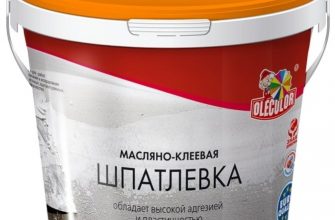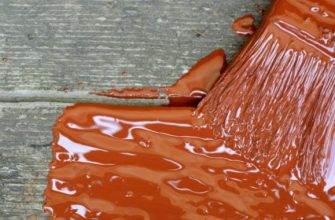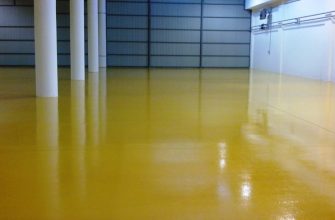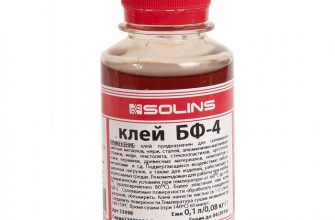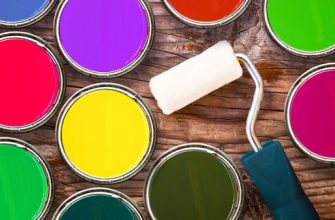The brickwork of the outer wall is carried out according to certain rules. It is necessary to observe not only the order of laying, but also the proportions of the mortar holding the structure together, otherwise it will be short-lived. The binder mixture is of several types, depending on the requirements for the structure.
Exterior brick masonry technology
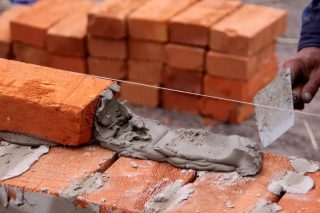
At first glance, the technology of laying brick walls is simple: a layer of cement mortar is applied to each row, then the next row of bricks is placed on it. And so on to the very roof. But the reality is much more complicated there are many factors to consider:
- first, the foundation surface is leveled horizontally so that there is no distortion;
- waterproofing is placed under the first layer of brick - most often roofing material;
- the first layer can be put directly on the waterproofing without using a solution, it will be needed in the next rows;
- the brick of the first row should be located across the foundation, the remaining 5 - longitudinally, so they alternate to the very roof;
- in the process of laying, it is necessary to constantly monitor the horizontal position; this is done with the help of a stretched rope and the amount of mortar.
Each subsequent row must be shifted by half a brick so that the structure is stable. Particular attention is paid to the corners of a building under construction: it is important to observe verticality - it is controlled using plumb lines.
An important condition when working with a solution: the thickness of the layer should not be more than 12 mm, otherwise the structure will crack over time.
Seam between bricks it can be concave or convex - it depends on what kind of wall decoration is planned - plaster or grout.
Solutions, their composition, proportions
In order for the building structure to be strong, the binder the solution must meet the following requirements:
- Plastic, to fill all the gaps between the bricks, as well as the technological holes in them.
- After solidification the mass should not deform due to lack of strength in the absence of any component in it.
- The cement binder must have time reserve for setting, in order to have time to use it all before the moment of solidification.
The strength of the structure ultimately depends on on the quality of building materials, their correct proportions in the mixture, as well as the quality of the batch.
Masonry mortar is a combination of binder and aggregate. The binder is cement, the aggregate is most often sand or other materials.
Cement-sand
A mixture is prepared from cement, sand, water and various additives, which give it resistance to frost, help to withstand high humidity (which is especially important for the foundation). Fiber or magnesium compounds, gypsum, ground limestone can be used as binders.
If the solution is simple, it will contain only the main components - cement, sand and water. All other components are added to the complex ones.
Depending on the composition DSP has the following properties:
- Good adhesion with smooth surfaces, for example, with gas blocks, foam blocks, smooth varieties of natural stone.
- Normal solution reduces thermal conductivity when laying bricks with cavities. This increases the thermal insulation properties of the wall.
- Subject to the exact proportions of the cement-sand mixture over time does not delaminate.
- When using porous aggregates, it is possible to achieve strength up to 1500 kg per cubic meter... When using dense aggregates, the strength index increases up to 2700 kg per cubic meter.
- Organic plasticizers make a solution less hygroscopic, which is important when laying out the foundation in regions with high average annual precipitation.
- Solution mobility is determined by dipping the cone into the mixture just made. The deeper the cone plunges, the greater the degree of mobility. It is generally accepted that for a solid brick wall, a mixture of a level of 9 - 10 mm is needed; for hollow brick walls 7 - 8 mm; for floor screed 5 - 6 mm. The degree of fluidity of the mixture can vary from 8 to 12 mm.
Binders additional components in the DSP can affect the following mixture characteristics:
- vapor permeability - an important indicator, since it does not contribute to the growth of fungus on the walls;
- resistance to temperature extremes;
- viscosity - improves the adhesion of the components of the mixture to each other in the solution;
- fire resistance;
- plastic;
- strength - the ability to withstand the pressure of subsequent rows of masonry;
- resistance to microorganismsthat are capable of gradually destroying cement.

Cement-limestone
Different versions of limestone solutions are prepared with the addition of cement, clay, sand. The main quality of the solution is plasticity. It is easy to apply to the wall, the mortar adheres well and adheres to a smooth surface.
Cement-lime plaster can be used without humidity restrictions, for example, in the bathroom, swimming pool, facade decoration. The mixture is laid on any surface.
The composition of the lime-cement mixture includes 4 components - cement, sand, quicklime, water... The brand of cement is selected depending on the intended purpose: for outdoor work M500 or M400, for interior work, M150 is enough.

Cement-clay
Clay absorbs excess moisture, then gives it away, if the dryness of the air increases, therefore, the microclimate in a room whose walls are plastered with clay is always better and healthier.
In order for the solution to meet the required indicators, it is necessary to choose the right fat content of the clay... You can also buy it ready-made to make a mortar at home.
No cement-clay mortar is used for laying stoves and fireplaces, since clay retains heat well, it is plastic and does not crack when the surface is heated and cooled. While cement is gradually destroyed due to high temperatures.
Self-preparation of the solution
First you need calculate the amount of mortar... For laying a brick wall, its consumption is approximately 25% of the total mass. The size of the brick is taken into account (the larger it is, the less mortar will go away).
Calculation example mortar for a small house 4x6 m: if you lay out a wall of 2.5 solid bricks measuring 25x12x6.5 cm, you will need about 10 m³ of cement-sand mixture. Next comes the calculation of the number of materials of the desired brand.
Kneading technology
It is necessary to mix the components immediately before starting work., since the setting time of the universal solution is about 1 hour. The order of laying in a concrete mixer is as follows:
- Sift all the components of the future solution through a sieve. This will make the composition more uniform. Check the sand for impurities - fill it with water, if it becomes cloudy, then the sand contains clay and it is better to use another one.
- Pour water into a concrete mixer or bucket where mixing will take place. Leave a little for topping up.
- Pour in the plasticizer.
- Fill in half of the total volume of sand.
- Pour in all the cement.
- Turn on the concrete mixer and mix for 2-3 minutes.
- Add the rest of the sand and mix again.
- Top up the remaining water if necessary.
Correctly made mortar should not stick to the trowel and slide over it.
The ratio of components for different brands
Can be done compositions of the following proportions:
- M50 or M100 with the addition of lime. The mortar is intended for repair and plastering work. The solution can be used to cover up small cracks or potholes in the walls.
- M150 - has universal characteristics. It can be used for masonry or plastering, screed or room renovation. After preparation, DSP must be applied to the desired surface within 2 hours, then leave for 24 hours for complete hardening. It is applied in a layer from 5 mm to 50 mm.
- M200 - intended for pouring screed, masonry work, starting plastering.
- M300 is considered to be an ultra-strong concrete mix. It is used for laying the foundation of a multi-storey building, screed. Due to the increased density, the mixture is not suitable for plastering work.
- For floor screed. Used cement grade M500. For 50 kg (1 bag), 15 buckets of 10 kg of clean sieved sand will be required. The ratio is 1: 3. Water for dilution 4 buckets of 10 liters. Consumption per 1 m3 of 9 bags of cement, 95 buckets of sand and 20 buckets of water.
- Mortar for brickwork. Used cement grade M400 or M500. In this case, the ratio of cement and sand should be 1: 4, that is, for 50 kg of cement, 16 ten-liter buckets of sand, as well as 4 buckets of water. Consumption for only 1 m3 6 bags of cement, 96 buckets - sand, 23 - water.
- For plastering bricks or other surfaces. 50 kg of cement M400, 27.5 buckets of sand with a volume of 10 liters, 4 buckets of water. Slaked lime is added at the rate of 1 bucket of cement 1 bucket of lime. How much material will it take to mix 1m3 of mortar: 350 kg of cement, sand - 192.5 buckets, water - 24 buckets.
For a high-quality hitch, the proportions must be observed exactly.
Determination of the mobility of the solution
Mobility denoted by the letter "P" and a coefficient from 1 to 5. The first 3 positions are inactive solutions, and 3 and 4 are fluid mixtures. Using a special construction cone, shrinkage and flow rate can be determined. If it is less than 5 cm - the mixture is heavy, from 5 to 15 cm - medium heavy, from 15 cm - a mobile solution.

